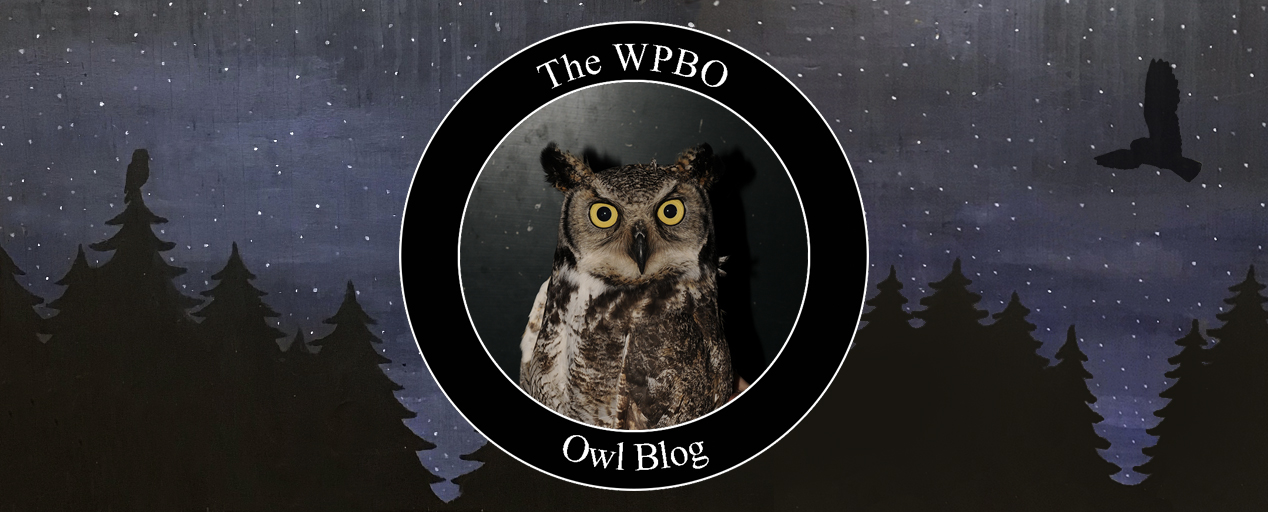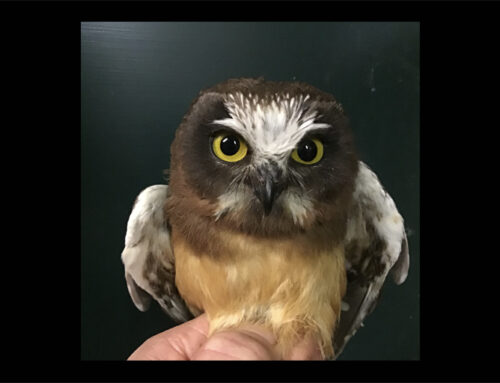After getting skunked on April 3, the owl migration finally kicked in this past week, including a night when we banded 110 owls — 39 Northern Saw-whet Owls (NSWO) and 71 Long-eared Owls (LEOW). This total represents the second-biggest night of owl banding ever at WPBO. The LEOW total is a new nightly total record for WPBO and likely for North America. We also banded the first Great Horned Owl (GHOW) of the season and two more Boreal Owls. All told, we banded 249 owls this week and recaptured 11 NSWO and one LEOW that had been previously banded.
Although Great Horned Owls breed in the general area, they are relatively uncommon at the Point. The last one banded in the spring was in 2020, and we have only banded 15 during our previous 19 spring seasons together at WPBO. Nothing snaps us to attention as thoroughly and quickly more than seeing a great horned in one of our nets. You do not want to make a mistake going in to get control of the feet on one of these guys.
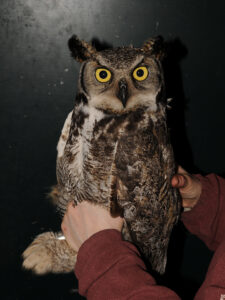
The spring’s first, and perhaps only, Great Horned Owl. Photo by Chris Neri
There were two recaptures of particular interest this week. One was a long-eared originally banded here as an adult in the summer of 2019. Long-eareds are notorious for how few recaptures they generate, so we are always particularly excited when we catch one with an old band. We know from the original banding data that she will be at least seven years old this summer. She was originally banded by Hannah Toutonghi, adding Washington to the list of states where former WPBO owl banders are when we text them a photo of a recaptured owl that they banded at WPBO.
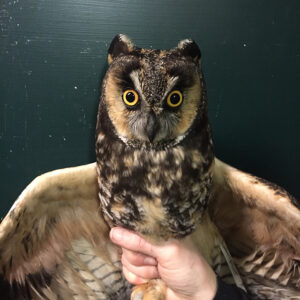
This recaptured Long-eared Owl from summer 2019 will be at least seven years old this summer. Photo by Chris Neri
The second exciting recapture was of a male saw-whet we banded as a juvenile last summer. The vast majority of NSWO banded during spring and fall migration across their range are females. Comparatively, we see a much higher percentage of males among the juveniles we band in the summer. However, among the hundreds of recaptures of the juveniles, this is just the third male to be recaptured, and the first to be recaptured here.
A little additional nature note, spotted salamander, blue-spotted salamander, eastern newt, spring peeper, and wood frog, all of our typically early spring amphibians, made their first appearances this week.
Season Totals of Banded Owls
Northern Saw-whet Owls: 219
Long-eared Owls: 104
Boreal Owl: 3
Great Horned Owl: 1
Total Owls: 327
~ Chris Neri & Nova Mackentley
2024 Spring Owl Banders
You can read the owl banders’ weekly blog posts and follow WPBO’s social media (Facebook, Instagram, and X) for owl banding highlights this season.
The spring owl banding season runs from March 15 through May 31.
Owl Banding Presentations — Visitors may observe owls that have been banded on Friday and Saturday evenings from dusk until midnight. Please note that banding is weather dependent and it is at the banders’ discretion to cancel banding accordingly. Observation will be limited to outdoors only. For the safety of the owls, flash photography and recording video is prohibited.
Nova Mackentley and Chris Neri: 2024 Spring Owl Banders
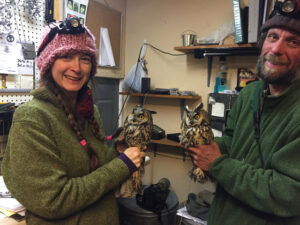 A lifelong birder, Chris became particularly fascinated with owls at the age of eight. He was introduced to owl banding by Katy Duffy in Cape May, NJ, in the mid-90s and knew after the first night that his life had just been changed. He has since worked with birds of prey in NV, NJ, NM, ID, CA, OR, MN, and his home state of PA. His life changed again when he arrived for his first season of owl banding at WPBO in the spring of 1999. As he puts it, “I have been fortunate enough to spend seasons at some of the premier raptor sites around the country working on some great research projects, but nothing has captured me the way the owl migration at Whitefish Point has.”
A lifelong birder, Chris became particularly fascinated with owls at the age of eight. He was introduced to owl banding by Katy Duffy in Cape May, NJ, in the mid-90s and knew after the first night that his life had just been changed. He has since worked with birds of prey in NV, NJ, NM, ID, CA, OR, MN, and his home state of PA. His life changed again when he arrived for his first season of owl banding at WPBO in the spring of 1999. As he puts it, “I have been fortunate enough to spend seasons at some of the premier raptor sites around the country working on some great research projects, but nothing has captured me the way the owl migration at Whitefish Point has.”
Originally from upstate New York, Nova first came to Michigan as a pianist and graduated from Interlochen Arts Academy. From there, it was an adventurous trek through Carnegie Mellon University and Oberlin College, studying abroad in Tanzania and earning her B.A. in Biology. Nova has loved Whitefish Point and the unique owl migration from the minute she was first hired as an owl bander back in 2005. She has worked with passerines, owls, hawks, parrots, ground squirrels, and ocelots at various field sites worldwide, but the owls always bring her back to Whitefish Point.
During their many years at WPBO, Nova and Chris have substantially upgraded the spring owl banding, discovered a unique movement of juvenile Northern Saw-whet Owls during the summer, coauthored several papers on owls, and feel grateful to call the U.P. their home. As nature photographers, Whitefish Point and its wonders have inspired much of their photography.

